垄断竞争和寡头垄断
垄断竞争和寡头垄断概论

垄断竞争和寡头垄断概论1. 引言垄断竞争和寡头垄断是市场竞争的两种不同形式。
在垄断竞争中,存在许多小规模的企业,每个企业都有一定的市场份额,但没有明显的市场支配地位。
相比之下,寡头垄断中只有少数几家企业主导市场,它们控制着市场的供应和价格。
本文将介绍垄断竞争和寡头垄断的特点、优缺点以及对市场和消费者的影响。
2. 垄断竞争垄断竞争是一种市场结构,其中存在许多相互竞争的小规模企业。
这些企业之间各自生产相似但稍有差异的产品。
垄断竞争市场的特点如下:•产品差异化:每个企业都努力通过产品特性、品牌形象、售后服务等方面的差异化来吸引消费者。
企业在一定程度上可以通过创新来获得竞争优势。
•自由进出市场:由于市场规模较小,新企业可以相对容易地进入市场。
因此,垄断竞争市场上的企业竞争程度较高。
•价格接近边际成本:由于市场竞争的存在,企业往往会以接近边际成本的价格出售产品,以吸引消费者。
垄断竞争的优点在于,它鼓励企业进行创新和差异化,促进产品质量的提高。
此外,竞争激烈的市场通常会降低产品价格,使得消费者能够以较低的价格购买到所需的商品和服务。
然而,垄断竞争市场也存在一些缺点。
首先,由于企业间差异化程度高,消费者往往需要花费更多的时间和精力来选择适合自己的产品,导致信息不对称问题。
其次,由于市场竞争激烈,企业利润空间较小,这可能导致企业对研发和创新的投入不足。
3. 寡头垄断与垄断竞争不同,寡头垄断市场由少数几家占据主导地位的企业组成。
这些企业通过控制市场供应和定价来影响市场竞争。
寡头垄断市场的特点如下:•企业数量有限:市场上只有几家企业主导市场,它们拥有较大的市场份额。
•产品差异化程度较低:相比于垄断竞争市场中的企业,寡头垄断市场中的企业生产的产品差异化程度较低,消费者的选择余地较小。
•高度集中的市场力量:寡头垄断企业通常具有较强的市场份额和影响力,能够通过控制市场供应和定价来影响市场竞争。
寡头垄断的优点在于,企业可以通过控制市场来实现较高的利润水平,从而有更多的资金用于研发创新和提高产品质量。
管理经济学 第8章 垄断竞争和寡头垄断

P
SMC SAC
LMC LAC
P1
D MR 0 Q
1
D’ Q
11
图 8-3 垄断竞争企业的长期均衡
垄断竞争企业长期均衡的条件是
MR=LMC=SMC
P=LAC=SAC
MR=LMC=SMC,利润没有最大化或 亏损没有最小化;
LMC=SMC,生产规模没有调整到 长期中最优;
12
P=LAC=SAC,有经济利润或亏损;
52
企 企 业 乙 高价 低价 高价
业
甲 低价 50, 120 60, 60
100, 100 120, 50 图 8-9
价格战
53
大家采取高价政策,大家都赚100; 一个高价,一个低价,高价者赚 50,低价者赚120; 两个都低价,两个都只能赚60。 大家都应该采取高价政策,但是, 大家都要对付对方的低价政策,所 以大家都采取低价政策,结果每个 人的明智选择是群体的非明
22
也就是说,以原来的交点位置决 定价格和产出,与需求曲线变动 后的新交点的价格和产出比较, 如果收入增加,则此方案可以采 纳。
23
P P2 P1 H2 H1 A1
MC 2 AC1 MC 1 A2 AC 2 D2
D1 C1 C2 MR 1 MR 2
0
Q1
Q2
Q
改进产品质量的成本影响
24
追加广告对成本的影响:
31
问题4:
寡头的名声不佳,但是,它的 产生又往往是经济的,为什么?
32
P A AC P1 P2 4 Q3 3 2 Q2 Q1 1
0 E F G H Q 寡头市场产生的必然与寡头市场的划分
33
二、拐折的需求曲线模型 寡头市场的价格比较稳定,寡 头之间一般不进行价格竞争。美国 经济学家斯威奇用拐折的需求曲线 模型对之作出了解释。
垄断竞争与寡头垄断市场

第七章垄断竞争与寡头垄断市场第一节垄断竞争市场一、基本含义与特征:1.含义:垄断竞争市场是既存在竞争又存在垄断的市场结构。
是现实经济生活中最为常见的一种市场结构。
2.特征:(1)市场上有众多的消费者和厂商,每个厂商所占的市场份额较小。
(2)厂商生产的产品存在着差别,即有很大的替代性。
而这种差别的存在是垄断竞争形成的基本条件。
产品的差别包括产量本身的差别和销售条件等方面的差别,正是由于这种差别是企业对自己的产品的垄断成为可能,但产品替代性又促使在市场上同类产量之间激烈竞争。
(3)从长期来看,厂商进入或退出一个行业是自由的。
二、垄断竞争厂商面临的市场需求曲线在垄断竞争市场上,由于每个厂商提供的产品有一定的差异,厂商可以对其产品实施垄断,厂商具有影响产品价格的能力,因而垄断竞争厂商的需求曲线(收益曲线)向右下方倾斜。
即边际收益曲线在需求曲线的下方(如同完全垄断市场结构一样) 。
当个别厂商所面临的需求曲线可能有两种情况:(1)当一个厂商降低自己产品价格,该行业中其它与之竞争的厂商并不随之改变价格时,在这种情况下,该厂商的销售量就会大幅度的变动,那么该厂商的需求曲线比较平坦;(2)如果其它厂商随之该厂商降价,在这种情况下,该厂商很难吸引其他消费者的需求,这时该厂商的销售量就不会有很大的变动,其需求曲线比较陡直。
三、垄断竞争厂商的短期均衡在短期,垄断竞争的企业对生产要素的调整只能限于可变投入,因而厂商面对成本的是短期成本。
由于改行业的厂商数目众多,有可能其他厂商不参与竞争,在这种情况下,该厂商通过不断降低价格,增加销售量,直到满足于边际成本=边际收益MR= MC的原则,就能够实现利润最大化。
所以,在短期均衡实现过程中,垄断竞争市场如同完全垄断市场一样,也会出现有超额利润、收支相抵、亏损三种情况。
四、垄断竞争企业的长期均衡垄断竞争市场的长期均衡实现,如同完全竞争市场一样,也是通过个别厂商产量的不断调整和行业生产规模的不断调整,最终就会实现长期均衡。
第11章 垄断竞争与寡头垄断
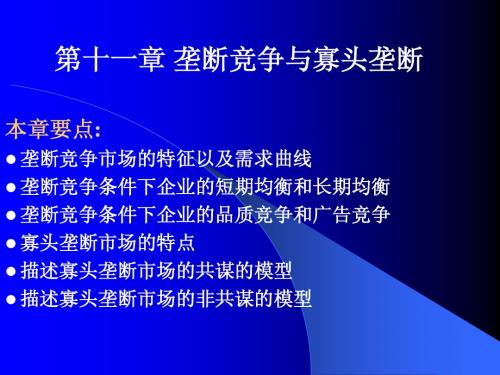
同理可得 TRB PQB [120 (QA QB )]QB 120QB QAQB QB 2
1 MRB 120 QA 2QB MC 0 QB 60 QA 2
企业A的反应函数
1 QA 60 QB 2 1 QB 60 QA 2
广告决策的简单法则: A/PQ = -(EA/EP) A:广告投入 P:商品价格 Q:商品销售量 EA :需求的广告弹性 EP :需求的价格弹性 这说明:广告费用占销售额的比例,取决于需求的广告 弹性和价格弹性。如果需求对广告非常敏感,而需求又 缺乏价格弹性时,企业应该大做广告。 一般,销售略有差别的消费品的企业,例如销售成药、 香水、化妆品、饮料、牛仔裤的企业,通常都把销售额 的10-30%用于广告;出售工业品的企业,一般用于广告 的支出很少;而出售同质产品的企业,例如销售小麦、 花生等的企业,根本没有公告支出。
垄断竞争企业的短期均衡条件: mr =SMC 利润最大化的条件 d=D 市场供求均衡的条件
三、垄断竞争企业的长期均衡
长期中,超额利润会吸引新企业进入,D需求曲线不断左移,d 需求曲线不断下降,直到超额利润全部消失,达到长期均衡。 A1 A2D2 Q2 mr2 Q1 D1 d2
图11-2 垄断竞争企业的长期均衡
•卡特尔的统一定价 根据市场需求曲线,利用MR=MC确定全体企业的均衡产 量,同时也确定了均衡价格——统一价格。
图11-6 卡特尔及其定价 (假定只有两家企业)
卡特尔的市场分配 (1)非价格竞争 在同一价格下,各企业采取广
告,信用、服务等非价格竞争手段争取市场销路
(2)配给定额
通常有三种标准:企业的地位和 争议能力、企业此前的销售额和生产能力;地理区划
垄断竞争与寡头垄断市场中产量及价格的决定

垄断竞争与寡头垄断市场中产量及价格的决定垄断竞争和寡头垄断市场是市场结构的两种常见形式。
在垄断竞争市场中,存在多家相似但不完全相同的企业,每家企业都有一定的市场份额,但没有明显的市场主导者。
而在寡头垄断市场中,只有少数几家企业控制着市场,并且它们的产品可以不完全相同或具有一定的差异化。
在垄断竞争市场中,企业的决策是基于预期利润最大化原则。
企业考虑到市场竞争的存在,会根据市场需求弹性、成本水平和竞争对手的行为来决定自己的产量和价格。
由于市场中存在相似但不完全相同的产品,企业通过产品差异化来寻求竞争优势。
这种差异化可能表现为品牌、质量、功能或服务等方面的差异。
在垄断竞争市场中,企业的规模并不足以对市场产量和价格产生显著影响。
因此,企业通常会以利润最大化为目标,同时考虑市场需求和成本条件,决定自己的产量和价格。
如果企业认为市场需求弹性较高,即市场对价格变动较为敏感,企业可能会将自己的价格设置较低,以吸引更多的消费者。
反之,如果企业认为市场需求弹性较低,即市场对价格变动不太敏感,企业可能会将自己的价格设置较高,以追求更高的利润。
而在寡头垄断市场中,少数几家企业可以通过协商或竞争来决定市场产量和价格。
这些企业可能会通过达成卡特尔协议等形式的合作,共同决定市场产量和价格,以实现利润最大化。
当然,这种合作往往面临着监管机构的监督和干预,以防止卡特尔行为对消费者权益的损害。
总的来说,垄断竞争市场和寡头垄断市场中的企业都会通过利润最大化的原则来决定自己的产量和价格。
在垄断竞争市场中,企业通过产品差异化来获得竞争优势,而在寡头垄断市场中,少数几家企业可以通过协商或竞争来决定市场产量和价格。
无论是哪种市场形式,企业的决策都会受到市场需求、成本条件和竞争对手行为的影响。
在垄断竞争市场中,价格和产量的决定过程更加复杂。
每个企业都希望提高自己的市场份额,因此在考虑市场需求和成本条件的基础上,决策者通常会采取一些策略来引起消费者的关注,并获得竞争优势。
垄断竞争和寡头垄断

垄断竞争和寡头垄断垄断竞争是指有许多厂商在市场上销售近似但不完全相同的产品。
垄断竞争市场的定义:是指一个市场中有许多厂商生产和销售有差别的同种产品的市场组织。
寡头垄断是指一种由少数卖方(寡头)主导市场的市场状态。
在企业竞争中有的企业为了达到垄断,市场力量更大。
卖不尽相同的产品,想进入卖东西都是可以进行的。
那么寡头还有一个更为重要的特征就是容易达成共谋,这点十分重要的,尤其是在博弈论的时候。
怎样区▲分垄断竞争和寡头垄断,下面小编和您仔细聊聊。
垄断竞争是指许多厂商生产并出售相近但不同质商品的市场现象。
其特征是:(1)企业数量多但规模相对比较小(2)产品相似又彼此差别,因而需求曲线向下倾斜(3)企业进出不受限制,资源可以在行业间转移(4)众多小的购买者。
▲寡头垄断是指一种由少数卖方(寡头)主导市场的市场状态。
寡头垄断是同时包含垄断因素和竞争因素而更接近于完全垄断的一种市场结构。
它的显著特点是少数几家厂商垄断了某一行业的市场,这些厂商的产量占全行业总产量中很高的比例,从而控制着该行业的产品供给。
寡头垄断企业的产品可以是同质的,也可以是有差别的。
前者有时被称为纯粹寡头垄断,后者则被称为有差别的寡头垄断。
寡头垄断的市场存在明显的进入障碍。
这是少数企业能够占据绝大部分市场份额的必要条件,也可以说是寡头垄断市场结构存在的原因。
最重要也是最基本的因素是这些行业存在较明显的规模经济性。
如果这些行业中要容纳大量企业,则每家企业都将因生产规模过小而造成很高的平均成本。
规模经济性使得大规模生产占有强大的优势,大公司不断壮大,小公司无法生存,最终形成少数企业激烈竞争的局面。
对试图进入这些行业的企业来说,除非一开始就能形成较大的生产规模,并能占据比较可观的市场份额,否则过高的平均成本将使其无法与原有的企业相匹敌。
对于寡头在市场中的行为,已有不少的理论和模型,但与其他三种市场理论相比,寡头理论要复杂得多,具体表现为:①种类多。
12垄断竞争和寡头垄断
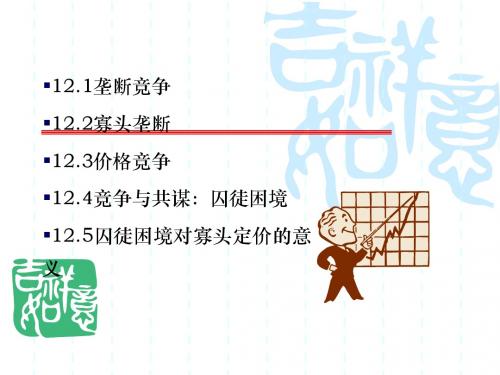
垄断竞争与经济效率
第二,垄断竞争厂商,它的产量是低于平均Байду номын сангаас本
最低时的产量水平。 为什么?有什么影响?
在完全竞争市场,零利润点出现在平均成本最低点。
而在垄断竞争市场,由于需求曲线是向右下方倾斜的
(需求曲线不可能和AC曲线的最低点相交),所以零 利润点在平均成本最低点的左边。 结论:不在平均成本最低点的产量是一种过剩,从而 是非效率的。
可以是自然产生的:比如由规模经济、专利、技术和品牌等形成; 也可以来自战略行动:比如制造过剩生产能力,控制重要投入要素。
寡头垄断市场特点
在寡头垄断行业中,战略行动更为重要与普遍。
因为只有少数厂商在竞争,因此,各厂商必须考虑 它的行为对它的对手有什么影响,以及它的对手会 如何反应。
比如,如果福特公司降价10%,竞争对手会有什么反应?
寡头垄断市场的均衡
在完全竞争、完全垄断以及垄断竞争市场,当确定产量和价
格时,不需要考虑竞争对手的反应。
而在寡头垄断市场,各厂商之间相互利害关系极为密切,他
们都是反应后再决策,固在产量和价格上没有“确定的均
衡”。
寡头垄断市场的均衡 均衡的定义:
企业达到这一状态后,不会主动寻求改变产量和
成自己的垄断地位。
广告是形成产品差别化
的一个重要原因。
垄断竞争市场最需进行
广告宣传。
其均衡条件为:MR=MC
垄断竞争市场的短期均衡
P SMC SAC P0
H
d(AR) MR
课本413页图12-1(a)
O
Q0
Q
垄断竞争厂商短期均衡的条件是:MR=SMC所决定的产量水平Q上, 此时,垄断竞争厂商可能获得最大利润,可能利润为零,也可能蒙受最 小亏损。
第十二章 垄断竞争与寡头垄断经典 西方经济学经典
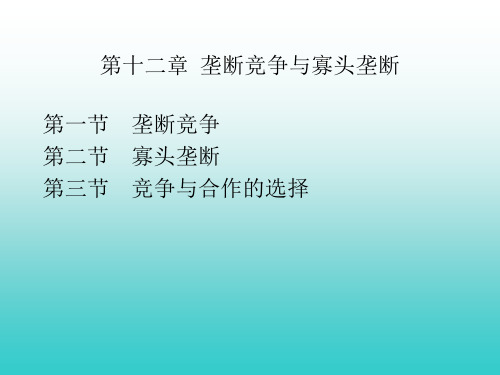
三、斯泰克伯格模型——结论
寡头1的实力强于寡头2; 寡头1先行占优; 寡头2则跟进追随,处于劣势
四、伯特兰模型——价格竞争的古诺模型 (一)同质产品的价格竞争
1. 寡头生产能力无限制时
D ( Pi ),Pi Pj 1 Di ( Pi,Pj ) D ( Pi ),Pi Pj 2 0,Pi Pj Pi Pj MC
四、伯特兰模型——价格竞争的古诺模型 (二)异质产品的价格竞争
寡头1和寡头2生产互为替代关系的异质产品 D1:Q` 24 4 p1 2 p2 D2:Q2 24 4 p2 2 p1 C1 C2 40
当
1 p1Q1 C1 24 p1 4 p12 2 p1 p2 1
4
3
E : 伯特兰均衡点
* * p1 p2 4 * Q1* Q2 16
2 1 1 2
3
4
5
6
p2
第三节 竞争与合作的选择
一、竞争还是合作 (囚徒困境) 寡头1 囚犯A P=4 P=6 坦白 抗拒
寡头2 P=4 P=6
24,24 40, 8 8, 40 32,32
囚犯B 坦白 抗拒
-3,-3 -1,-5 -5,-1 -2,-2
q
四、垄断竞争市场的效率
LMC
P, C, R
LAC
– 均衡价格 P完全垄断≥P垄断竞争≥P完全竞争
pl
– 均衡产量 q完全垄断≤q垄断竞争≤q完全竞争 – 资源利用效率 U完全垄断≤U垄断竞争≤U完全竞争
mrl
Dl
dl
O
ql
q
五、厂商之间的竞争
– 价格竞争
• 导致主观需求曲线和客观需求曲线
微观经济学第8章 垄断竞争和寡头垄断
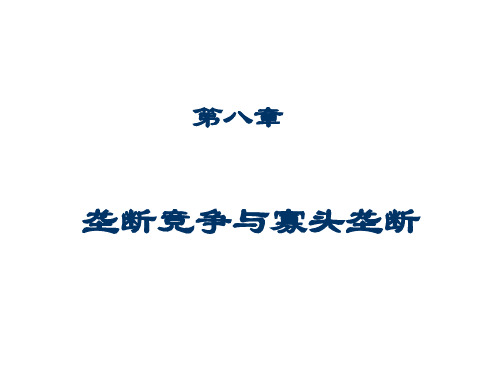
(四)斯威齐模型的评价
斯威齐模型的出现,曾一度得到理论界的肯定,
但也存在不同意见,主要是: (1)P0是如何形成的,模型未作解释;
(2)施蒂格勒认为该模型不具有通用性,许多寡
头垄断行业不存在弯折的需求曲线。
古诺模型的前提及其求解
古诺模型(The Cournot Model)是由法国经 济学家古诺在1838年出版的《财富理论的数学原理 研究》一书中首先提出的,模型虽然简单,却抓住 了寡头垄断情形所蕴含的丰富内容,因此受到关注 和引用。
P
p2 P0 P1
E
dd’
Q2
Q0
Q1
Q
2、比例需求曲线(客 观需求曲线)
同一行业所有厂商采取相 同的价格变动措施,以致各个 厂商产品销量发生同比例的变 化,这种反映价格变动与需求 量变动之间关系的曲线称为比 例需求曲线,它是由所有厂商 同时变动价格所形成的,故又 称为客观需求曲线。
P
P2
D
E2
E0 E1
D V
D’
O
Q0
Q
(三)价格刚性的解释 DV对应的MR=RA, VD’对应的MR=BR’, 折点V处,MR=AB。 RABR’构成寡头厂商的 MR曲线。
P
D R P0 V
A D’ B O R’ Q
Q0
AB段为垂直线的原因在于, 当没有其它因素引起寡头厂商 的MC大幅度下降的情况下,各 个寡头厂商单方面采取价格行 动都会引发价格战,结果两败 俱伤。为此,厂商一般不愿意 过多地调整价格,即使MC略有 变化,也会保持既定价格,从 而呈现价格刚性。
SAC1 SAC2
LMC
LAC
Pm Pc
E1 E2
dc (MRc=ARc dm (ARm)
完全竞争 垄断竞争 寡头竞争 完全垄断

完全竞争垄断竞争寡头竞争完全垄断市场分为完全竞争市场、垄断市场、垄断竞争市场和寡头垄断市场四种类型。
区别为:
1,完全竞争市场厂商很多,产品同质,任何厂商不能影响价格,进出行业容易,经济效益最高。
2,垄断市场厂商只有唯一一个,产品也是惟一的,且无相近的替代品,厂商在很大的程度上可以影响市场价格,进出行业极其困难,经济效益最低。
3,垄断竞争市场上厂商很多,产品之间存在差别,厂商对市场价格有一些影响,进出行业比较容易,经济效益较高。
4,寡头垄断市场的厂商有几个,产品有差别或无差别,厂商在相当程度上可以影响价格,进出行业比较困难,经济效益较低。
寡头垄断的市场寡头垄断是同时包含垄断因素与竞争因素并更接近于完全垄断的一种市场组织形式,它是由少数几家企业供应该行业的大部分产品、这几家企业的产量在该行业的总产量中各占较大的份额。
(一)寡头垄断的条件寡头垄断具有以下三个条件:(1)企业数目极少.(2)相互依赖.(3)企业进出不易。
(二)寡头垄断的特点寡头垄断最显著的特点是卖者必须认识到他们之间存在相互依赖关系.下面用图说明竞争对手的行为如何影响寡头垄断企业的需求曲线.每期数量dD价格(美元)寡头垄断企业的需求曲线。
(三)价格刚性:弯折的需求曲线模型需求曲线之所以是弯折的,是因为别的企业对一家企业的价格变化作出的反应不对称.弯折的需求曲线模
型的意义在于,寡头垄断市场结构下的企业的边际成本即使发生较大变化,仍不改变其价格.。
垄断竞争市场和寡头垄断市场中生产者的行为
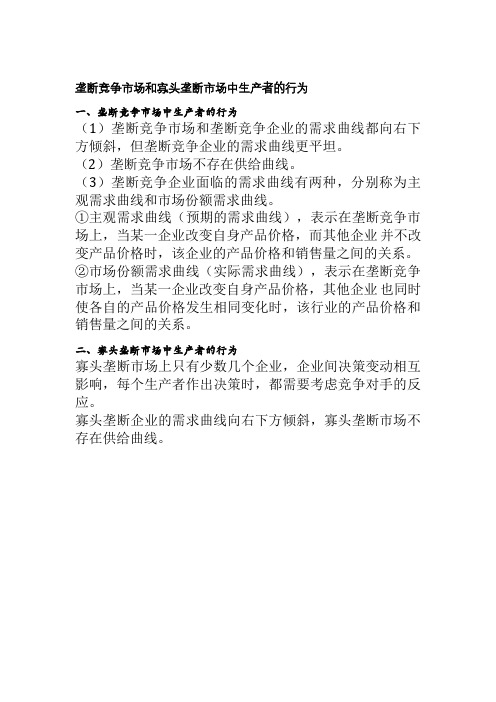
垄断竞争市场和寡头垄断市场中生产者的行为
一、垄断竞争市场中生产者的行为
(1)垄断竞争市场和垄断竞争企业的需求曲线都向右下方倾斜,但垄断竞争企业的需求曲线更平坦。
(2)垄断竞争市场不存在供给曲线。
(3)垄断竞争企业面临的需求曲线有两种,分别称为主观需求曲线和市场份额需求曲线。
①主观需求曲线(预期的需求曲线),表示在垄断竞争市场上,当某一企业改变自身产品价格,而其他企业并不改变产品价格时,该企业的产品价格和销售量之间的关系。
②市场份额需求曲线(实际需求曲线),表示在垄断竞争市场上,当某一企业改变自身产品价格,其他企业也同时使各自的产品价格发生相同变化时,该行业的产品价格和销售量之间的关系。
二、寡头垄断市场中生产者的行为
寡头垄断市场上只有少数几个企业,企业间决策变动相互影响,每个生产者作出决策时,都需要考虑竞争对手的反应。
寡头垄断企业的需求曲线向右下方倾斜,寡头垄断市场不存在供给曲线。
西方经济学第07章垄断竞争和寡头垄断市场

条件:产品差别的存在。 产品差别----同一种产品在质量、包装、牌号和销售条件等方面的差别。
一、垄断竞争市场的的厂商决策
2、市场特点: 既有垄断,产品存在差别; 某个企业先 自行定价。 又有竞争,各种有差别的 产品之间存在替代性; 企业根据市场再进行调价。
M”
N
N’
N”
寡头垄断的含义和市场特点:
1
含义:指少数几家企业控制整个市场 的供给。
2
特点:
3
大规模生产,其他厂商难以进入;
4
几家寡头之间的相互依存性。
5
二、寡头垄断市场上的厂商均衡
D-AR-P 向右下方倾斜, MR<AR。
AR=P
MR
3)市场表现
2、寡头垄断的若干模式:
(1)突点需求曲线模式: 当竞争对手对某一厂商的价格变动不予理睬,形成需求曲线D1。 但如果竞争对手竞相削价, 于是需求曲线发生弯折, 由D1到D2。
02
(2)博弈论模式
各寡头之间存在勾结,产量由各寡头之间协商确定,协商确定的取决于各寡头实力的大小。
寡头之间不存在勾结的情况下,各寡头根据其他寡头的产量来调整自己的产量,以达到利润最大化的目的。
01
02
3、寡头市场上产量的决定
各寡头不存在勾结:
价格领先制 价格决策往往由大企业作出,决定价格的大企业通常被称为价格领袖者,或者叫支配性企业;而小企业则如同完全竞争企业一样,是价格的接受者。
P1
D1
D2
Q1
Q2
K
结论
由于厂商按MR=MC利润最大化决策,即使MC曲线上移或下移, 只要范围适度,价格和 产量都会保持不变。 如右图:
垄断竞争与寡头垄断
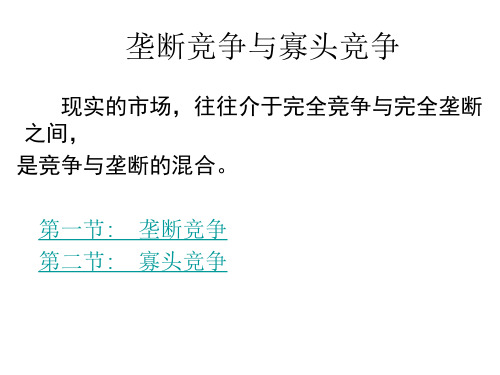
过去的10年里,苹果公司借力这几款明星产品销售额迅速增长 ,公司利润率持续处于行业内高水平。2004年以来,苹果公司一直保 持着两位数的增长率,平均利润率近32%。同时期,索尼公司的增长 率最高为13%,最低为负增长,其平均利润率近23%。
今年来,苹果产品销量继续增加:
第二节 寡头垄断市场
寡头垄断市场是介于垄断竞争与完全垄断之间 的一种市场类型。在这样一种市场条件下,厂商如 何决定自己的行为,决定自己的均衡价格与均衡产 量呢?
iPHONE
iphone相关数据
先来看iPhone。瑞士信贷的报告称,苹果iPhone自五年前发布后至 今,虽然不乏有实力的对手出现,但从系统、软件、芯片、品 牌等诸多因素构成的生态系统看,对手很难缩小与苹果iPhone 的优势差距。 在过去的2010年,苹果iPhone占据着智能手机市场16%的份额,位 居全球智能手机三甲之列,而在营收上,苹果凭借着这16%的份额获 得了29%的营收,排在第一位。 在以App Store为代表的软件应用上,HIS的统计显示,其收入达到 17.8亿美元,占据了四大程序商店总收入的82.7%,遥遥领先于同行 的对手。而ABI研究公司发布的有关应用下载的研究数据称,近79亿 个应用程序已被从移动应用商店中下载,这之中的56亿个来自于苹果 的App Store,占了70.9%。 总之,苹果iPhone不但在智能手机的整个生态系统,就是在生态系 统的各主要组成部分上都有着压倒性的优势。
2001年10月, 苹果公司推出第一款Mp3播放器( iPod G1)。
IPOD推出后, 大大改变了公司长期低迷的盈利状况。 该产品问世后,创造了惊人的销售奇迹,五年全球累计销量超过了6000万台。 纳斯达克的股票价格也随着iPod产品的不断升级和其销量的不断上升而一路走 高,从2001年9月每股不到10美元升至2007年1月16日最高的每股97美元;2012年5 月4日股价高达565.25美元。苹果电脑的销量也被iPod热销带动, 该公司财务报告 ,苹果电脑的销量增长了28%,销售额增长了40%。 在iPod成功的基础上,苹果公司的产品范围还得到了横向拓展,从apple tv(传 输转换装置)扩展到iPhone。
宏观经济学第9章 垄断竞争与寡头垄断市场

2、寡头垄断的成因
存在其他进入该市场的障碍 (1)某些产品的初始投资量很大; (2)技术要求高; (3)市场开拓难; (4)政府管制。
(二)寡头垄断的分类
按产品的性质分类: 纯粹寡头和差别寡头。 按厂商数目分类: 双寡头、三寡头和多寡头。 按厂商的行为方式分类: 独立行为寡头和勾结行为的寡头。
由于每个厂商的生产条件是相同的,在均衡产 q1 q2 qn 出水平上,则有:
因此上式可以写成: a (n 1)bq MC 0 1 1
a MC1 q (n 1)b
1
n(a MC1 ) Q nq (n 1)b
1
a n P a bQ MC1 n 1 n 1
* 1 * 2
2a Q 3b
古诺模型可以很容易推广到有n个相同厂商的 行业。市场需求函数为:
P a bQ a b(q1 q2 q3 qn )
假设所有厂商的边际成本相同, MC1 MC2 MCn 则厂商1利润最大化的一阶条件为:
a 2bq1 b(q2 q3 qn ) MC1 0
P P* P1
MC AC d
O 图 9-9
q*
q1 卡特尔的不稳定性
q
(五)斯塔克尔伯格模型
斯塔克尔伯格模型(Stackelberg model)描
述了在市场里,有一个处于支配地位的领导
厂商,有一个或多个追随厂商这样的行业。
与古诺模型的最根本区别
领导厂商在决定其最优产量时,把追随
厂商的反应函数看作是给定的,而不是 以它们的产量为给定的。
(六)价格领导
垄断竞争与寡头垄断
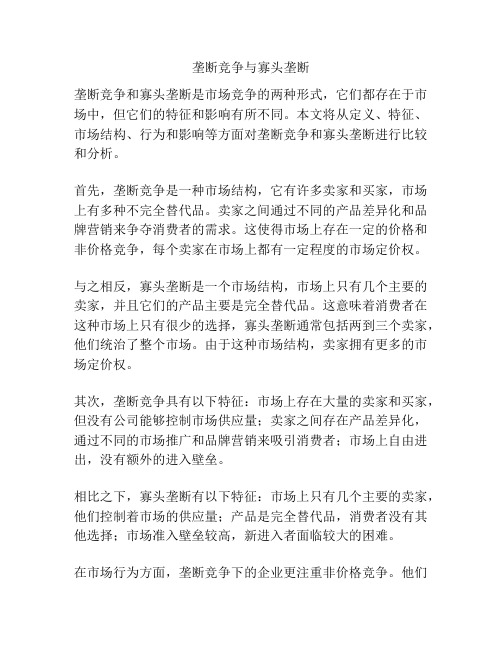
垄断竞争与寡头垄断垄断竞争和寡头垄断是市场竞争的两种形式,它们都存在于市场中,但它们的特征和影响有所不同。
本文将从定义、特征、市场结构、行为和影响等方面对垄断竞争和寡头垄断进行比较和分析。
首先,垄断竞争是一种市场结构,它有许多卖家和买家,市场上有多种不完全替代品。
卖家之间通过不同的产品差异化和品牌营销来争夺消费者的需求。
这使得市场上存在一定的价格和非价格竞争,每个卖家在市场上都有一定程度的市场定价权。
与之相反,寡头垄断是一个市场结构,市场上只有几个主要的卖家,并且它们的产品主要是完全替代品。
这意味着消费者在这种市场上只有很少的选择,寡头垄断通常包括两到三个卖家,他们统治了整个市场。
由于这种市场结构,卖家拥有更多的市场定价权。
其次,垄断竞争具有以下特征:市场上存在大量的卖家和买家,但没有公司能够控制市场供应量;卖家之间存在产品差异化,通过不同的市场推广和品牌营销来吸引消费者;市场上自由进出,没有额外的进入壁垒。
相比之下,寡头垄断有以下特征:市场上只有几个主要的卖家,他们控制着市场的供应量;产品是完全替代品,消费者没有其他选择;市场准入壁垒较高,新进入者面临较大的困难。
在市场行为方面,垄断竞争下的企业更注重非价格竞争。
他们通过产品差异化、广告宣传等方式吸引消费者。
由于市场上存在大量的卖家,卖家之间的价格竞争有限,因此价格更加稳定。
而寡头垄断下只有几个卖家,他们之间的竞争更多是价格竞争。
由于产品的完全替代性,卖家通过价格来争夺市场份额。
这可能导致价格战和竞争不完全透明,消费者往往受到损害。
最后,垄断竞争和寡头垄断对市场和消费者的影响也有所不同。
在垄断竞争下,由于市场上存在大量的卖家和非价格竞争,消费者受益于更多的选择和产品创新。
由于价格相对稳定,消费者也能够根据自己的需求做出更好的购买决策。
然而,寡头垄断可能对消费者和市场带来不良影响。
由于只有几个主要卖家,消费者的选择受到限制。
由于缺乏竞争,卖家可以操纵价格,从而提高利润,消费者可能需要支付更高的价格来购买产品。
中级微观经济学-第九章 垄断竞争与寡头垄断

y1
y2
(y1m,y2m) 表示最大化 卡特尔总利润的产量。
y2* y2m
y1m y1*
y1
(三)卡塔尔稳定性与瓦解
这样的卡特尔是否稳定? 厂商是否有欺骗其它厂商的动机?
例如, 假如厂商1保持y1m 的产量, 最大化
利润的厂商2是否会保持y2m的产量?
厂商2对厂商1产量y1 = y1m的利润最大化 反应函数为y2 = R2(y1m)。
y2
R2(y1m) y2m
y1 = R1(y2), 厂商1的反应函数
y2 = R2(y1m) 为对厂商1 产量y1 = y1m的最佳反 应产量。
y2 = R2(y1), 厂商2的 反应曲线。
y1m
y1
厂商2对厂商1产量y1 = y1m的利润最大化 反应产量为:y2 = R2(y1m) > y2m. 厂商2通过欺骗厂商1将产量从y2m提高至 R2(y1m)可以使其利润上升。
(二)垄断竞争市场条件
– 第一,在生产集团中有大量的企业生 产有差别的同种产品,这些产品彼此 之间都是非常接近的替代品。产品差 别不仅指同一种产品在质量、构造、 外观、销售服务条件等方面的差别, 还包括商标、广告方面的差别和以消 费者的想像为基础的任何虚构的差别 。
(二)垄断竞争市场条件
– 第二,一个生产集团中的企业数量非 常多,以至于每个厂商都认为自己的 行影响很小,不会引起竞争对手的注 意和反应,因而自己也不会受到竞争 对手何报复措施的影响。
第三节 同时决策模型
一、古诺模型
(一)模型假设
古诺模型是早期的寡头模型。它是由法 国经济学家古诺于1838年提出的。古诺 模型常被作为寡头理论分析的出发点。 古诺模型是一个只有两个寡头厂商的简 单模型,该模型也被称为“双寡头模型 ”。古诺模型的结论可以很容易地推广 三个或三个以上的寡头厂商的情况中去 。
垄断竞争与寡头垄断
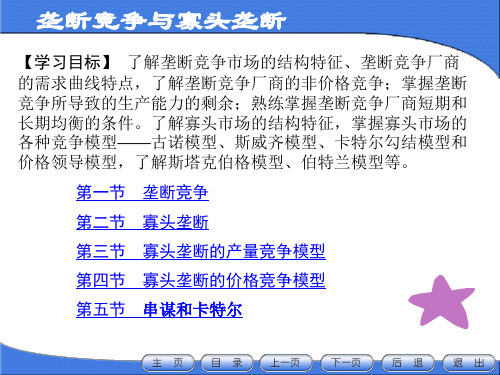
【学习目标】 了解垄断竞争市场的结构特征、垄断竞争厂商 的需求曲线特点,了解垄断竞争厂商的非价格竞争;掌握垄断 竞争所导致的生产能力的剩余;熟练掌握垄断竞争厂商短期和 长期均衡的条件。了解寡头市场的结构特征,掌握寡头市场的 各种竞争模型——古诺模型、斯威齐模型、卡特尔勾结模型和 价格领导模型,了解斯塔克伯格模型、伯特兰模型等。
垄断竞争厂商短期均 衡条件是:MR=SMC
P
可 能 有 PS 经 AR>AC 济 利 润
MC ATC
ES
MR
AR D
0
QS
Q
MR=MC决定产量
垄断竞争与寡头垄断
垄断竞争与寡头垄断
垄断竞争
四、非价格竞争
不通过降低价格而是通过增加产品其他特征的优势 进行竞争的方式
垄断竞争与寡头垄断
垄断竞争
非价格竞争
2.非价格竞争的方式 品质竞争 广告竞争
例:广告与特色
说我们生活在一个广告的世界里一 点也不夸张,那么企业为什么会不惜巨额代价 狂做广告呢?广告策划是在策划什么?广告的 目的是借助于非价格竞争手段来改变厂商自己 的主观需求曲线,因为形成了品牌特色以后, 别的企业就不可能用价格手段来掠夺已经属于 自己的客户了。同样,大学生在就业市场上也 是如此,如果你有很强的竞争力,你就没有必 要自跌身价去保住饭碗,当老板要降低工资时, 你就敢说“NO”;相反,如果你普普通通, 你就只能随波逐流。抓住大学时光,打造自己 的特色才能活得更精彩!
第一节 垄断竞争
第二节 寡头垄断
第三节 寡头垄断的产量竞争模型
第四节 寡头垄断的价格竞争模型
第五节 串谋和卡特尔
垄断竞争与寡头垄断
垄断竞争
一、垄断竞争的含义及市场特点
- 1、下载文档前请自行甄别文档内容的完整性,平台不提供额外的编辑、内容补充、找答案等附加服务。
- 2、"仅部分预览"的文档,不可在线预览部分如存在完整性等问题,可反馈申请退款(可完整预览的文档不适用该条件!)。
- 3、如文档侵犯您的权益,请联系客服反馈,我们会尽快为您处理(人工客服工作时间:9:00-18:30)。
A Monopolistically Competitive Firm in the Short and Long Run
In the long run, these profits attract new firms with competing brands. The firm’s market share falls, and its demand curve shifts downward. In long-run equilibrium, described in part (b), price equals average cost, so the firm earns zero profit even though it has monopoly power.
CHAPTER 12
Chapter 12: Monopolistic Competition and Oligopoly
Monopolistic competition and Oligopoly
1 of 35
CHAPTER 12 OUTLINE
12.1 Monopolistic Competition
7 of 35
12.1
MONOPOLISTIC COMPETITION
Monopolistic Competition and Economic Efficiency
Figure 12.2 (continued)
Chapter 12: Monopolistic Competition and Oligopoly
Chapter 12: Monopolistic Competition and Oligopoly
12.2 Oligopoly 12.3 Price Competition
12.4 Competition versus Collusion:
The Prisoners’ Dilemma 12.5 Implications of the Prisoners’ Dilemma for Oligopolistic Pricing 12.6 Cartels
In both types of markets, entry occurs until profits are driven to zero. In evaluating monopolistic competition, these inefficiencies must be balanced against the gains to consumers from product diversity.
Nash Equilibrium Equilibrium in oligopoly markets means that each firm will want to do the best it can given what its competitors are doing, and these competitors will do the best they can given what that firm is doing. ● Nash equilibrium Set of strategies or actions in which each firm does the best it can given its competitors’ actions. ● duopoly Market in which two firms compete with each other.
Because the firm is the only producer of its brand, it faces a downward-sloping demand curve. Price exceeds marginal cost and the firm has monopoly power. In the short run, described in part (a), price also exceeds average cost, and the firm earns profits shown by the yellowshaded rectangle.
1. Firms compete by selling differentiated products that are highly substitutable for one another but not perfect substitutes. In other words, the cross-price elasticities of demand are large but not infinite. 2. There is free entry and exit: it is relatively easy for new firms to enter the market with their own brands and for existing firms to leave if their products become unprofitable.
3 of 35
12.1
MONOPOLISTIC COMPETITION
The Makings of Monopolistic Competition
Chapter 12: Monopolistic Competition and Oligopoly
A monopolistically competitive market has two key characteristics:
Oligopoly is a prevalent form of market structure. Examples of oligopolistic industries include automobiles, steel, aluminum, petrochemicals, electrical equipment, and computers.
10 of 35
12.2
OLIGOPOLY
Equilibrium in an Oligopolistic Market
Chapter 12: Monopolistic Competition and Oligopoly
When a market is in equilibrium, firms are doing the best they can and have no reason to change their price or output.
Comparison of Monopolistically Competitive Equilibrium and Perfectly Competitive Equilibrium
Under monopolistic competition, price exceeds marginal cost. Thus there is a deadweight loss, as shown by the yellowshaded area. The demand curve is downward-sloping, so the zero-profit point is to the left of the point of minimum average cost.
Colas
Elasticity of Demand –2.4 –5.2 to –5.7 –6.4 –8.2 –3.6
Royal Crown Coke
Ground coffee
Folgers Maxwell House Chock Full o’Nuts
With the exception of Royal Crown and Chock Full o’ Nuts, all the colas and coffees are quite price elastic. With elasticities on the order of −4 to −8, each brand has only limited monopoly power. This is typical of monopolistic competition.
What matters is that only a few firms account for most or all of total production.
In some oligopolistic markets, some or all firms earn substantial profits over the long run because barriers to entry make it difficult or impossible for newf 35
12.2
OLIGOPOLY
The Makings of Monopolistic Competition
Chapter 12: Monopolistic Competition and Oligopoly
In oligopolistic markets, the products may or may not be differentiated.
Under perfect competition, price equals marginal cost. The demand curve facing the firm is horizontal, so the zeroprofit point occurs at the point of minimum average cost.
8 of 35
12.1
MONOPOLISTIC COMPETITION
Chapter 12: Monopolistic Competition and Oligopoly
TABLE 12.1 Elasticities of Demand for Brands of Colas and Coffee Brand
